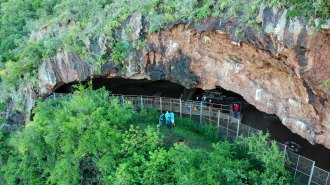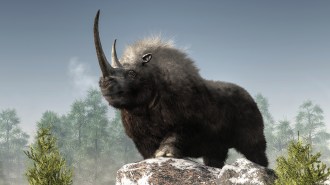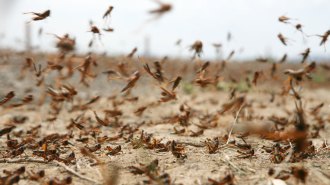All Stories
-
 Archaeology
ArchaeologyThe oldest known grass beds from 200,000 years ago included insect repellents
Found in South Africa, 200,000-year-old bedding remnants included fossilized grass, bug-repelling ash and once aromatic camphor leaves.
By Bruce Bower -
 Life
LifeClimate change, not hunters, may have killed off woolly rhinos
Ancient DNA indicates that numbers of woolly rhinos held steady long after people arrived on the scene.
By Bruce Bower -
 Health & Medicine
Health & Medicine4 reasons you shouldn’t trash your neck gaiter based on the new mask study
Despite news coverage to the contrary, the study was meant to figure out how to evaluate masks, not actually do the comparison.
-
 Physics
PhysicsFour types of flames join forces to make this eerie ‘blue whirl’
Pinning down the structure of the “amazingly complex” blaze could help scientists control it.
-
 Life
LifeA single molecule may entice normally solitary locusts to form massive swarms
Scientists pinpoint a compound emitted by locusts that could inform new ways of controlling the pests.
-
 Space
SpaceParadoxically, white dwarf stars shrink as they gain mass
Observations of thousands of white dwarf stars have confirmed a decades-old theory about the relationship between their masses and sizes.
-
 Health & Medicine
Health & MedicineHere’s what we know about Russia’s unverified coronavirus vaccine
Despite incomplete testing, Sputnik V may be the first COVID-19 vaccine given to the general public, rolling out initially to teachers and doctors.
-
 Science & Society
Science & SocietyA new Galileo biography draws parallels to today’s science denialism
‘Galileo and the Science Deniers’ delivers a fresh assessment of the life of a scientific legend and offers lessons for today.
-
 Health & Medicine
Health & MedicineHow two coronavirus drugs for cats might help humans fight COVID-19
Scientists are exploring if drugs for a disease caused by a coronavirus that infects only cats might help also people infected with the coronavirus.
-
 Cosmology
CosmologyScientists can’t agree on how clumpy the universe is
A measurement of 21 million galaxies finds a level of clumpiness that disagrees with estimates based on the oldest light in the universe.
-

-
 Neuroscience
NeuroscienceNew guidance on brain death could ease debate over when life ends
Brain death can be a tricky concept. Clarity from an international group of doctors may help identify when the brain has stopped working for good.